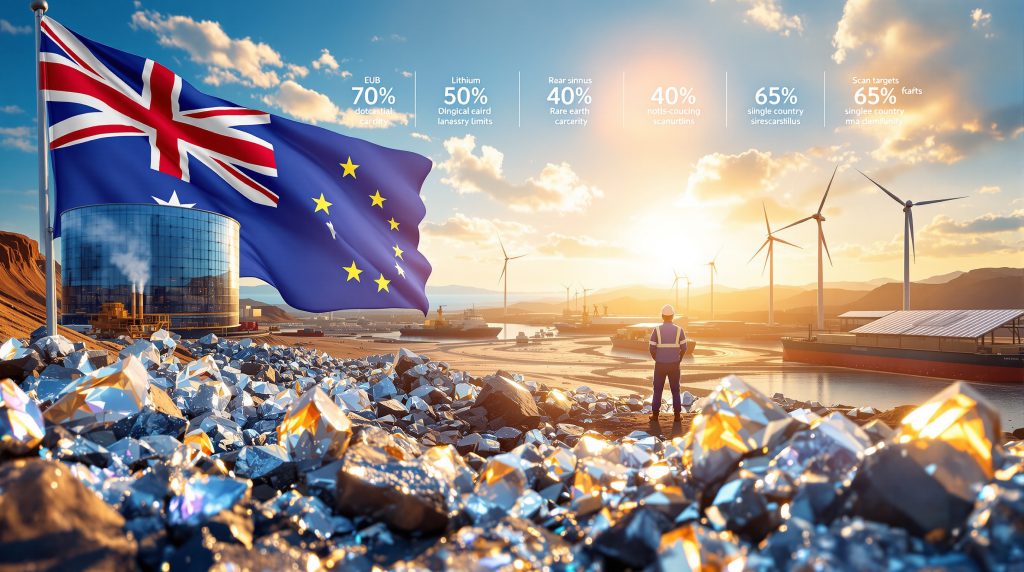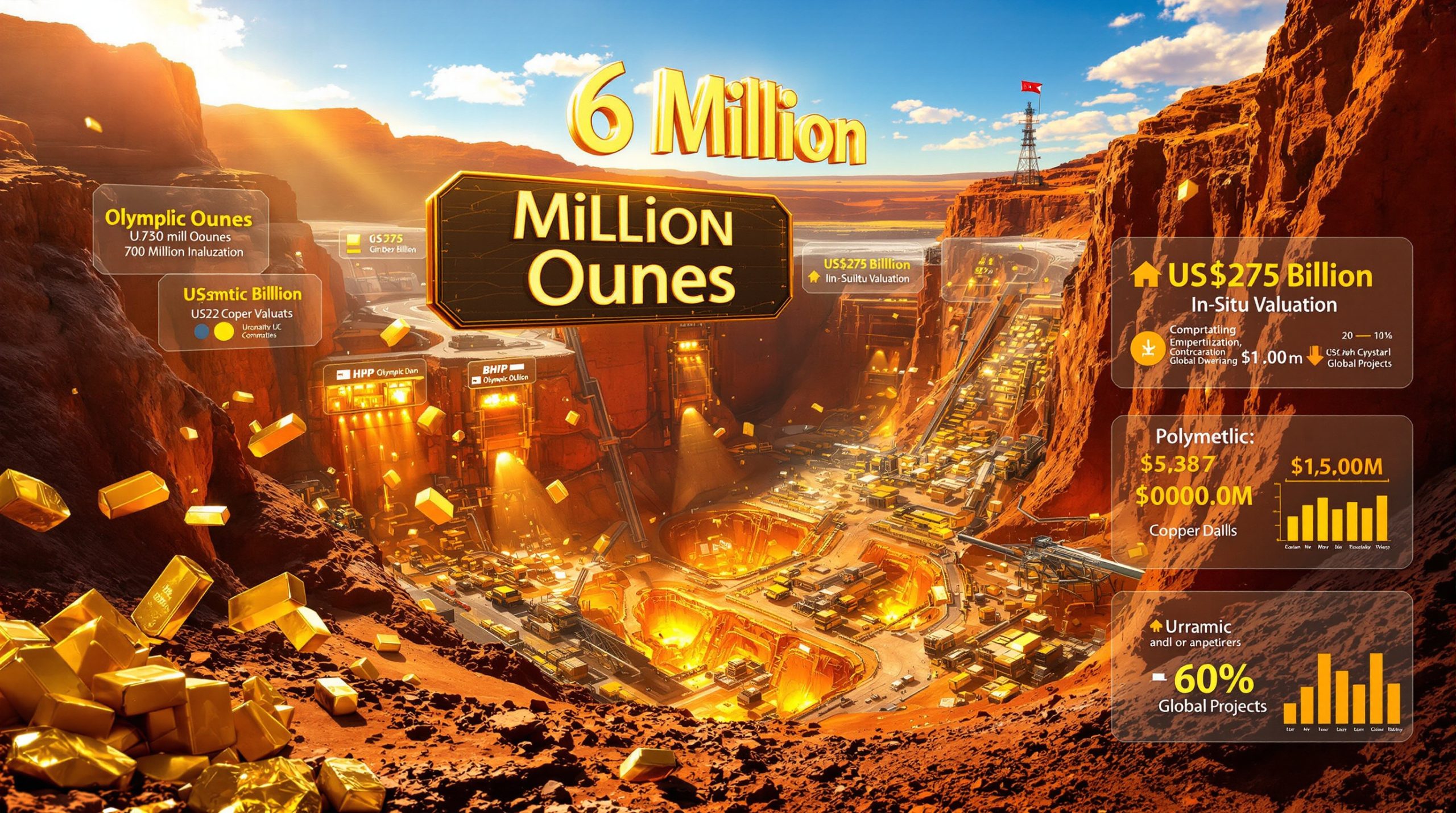European Investment Bank Transforms Critical Materials Strategy Through Australian Partnership
The European Investment Bank and Australia critical raw materials partnership has fundamentally restructured its approach to critical materials financing by establishing specialised investment mechanisms targeting supply chain vulnerabilities across global markets. In early 2025, the institution created a dedicated task force with an explicit mandate to double financing capacity for critical materials projects worldwide, representing a significant departure from traditional development banking practices.
This strategic transformation focuses specifically on materials essential for renewable energy technologies, electric vehicle batteries, and advanced manufacturing processes. The bank's restructured framework prioritises projects demonstrating both commercial viability and strategic importance to European supply chain security, moving beyond conventional risk assessment models toward geopolitically informed investment decisions.
The EIB's investment approach encompasses multiple financial instruments including direct equity participation in mining ventures, debt financing for processing facility construction, technical expertise sharing programmes, and comprehensive supply chain integration support. This multifaceted approach enables mining companies to accelerate project development timelines while simultaneously meeting enhanced environmental and operational standards that exceed traditional industry benchmarks.
Australia Emerges as Europe's Strategic Critical Materials Partner
Australia's selection as a primary partner reflects its exceptional geological endowments combined with institutional characteristics that address European supply security concerns. The continent possesses the world's second-largest rare earth element reserves and maintains top-tier global lithium production capacity, positioning it as an ideal counterbalance to concentrated Asian supply chains that currently dominate global markets.
The partnership timing strategically aligns with implementation of Europe's Critical Raw Materials Act, which establishes specific diversification mandates by 2030. Australia's democratic governance structure, transparent regulatory frameworks, and established relationships with international capital markets provide institutional assurance regarding supply continuity and fair market access that many alternative suppliers cannot consistently demonstrate.
Beyond geological advantages, Australia offers advanced mining technology expertise, proven operational capabilities, and commitment to environmental and social governance standards that align with European institutional requirements. These characteristics reduce project execution risk while providing investors with legal predictability and operational transparency essential for large-scale capital deployment.
The geopolitical dimension addresses European concerns about supply agreements with authoritarian regimes or nations with contested territorial claims that might weaponise resource access during political disputes. Australia's alignment with Western security interests provides additional assurance regarding long-term supply reliability and strategic cooperation.
Current supply chain concentration demonstrates the urgency driving this partnership. With the exception of Japan, Group of Seven countries and the European Union remain heavily or exclusively reliant on China for materials ranging from rare earth magnets to battery metals. China encompasses 70% of rare earth production and 90% of global processing capacity, creating systemic vulnerabilities to Chinese policy decisions regarding export restrictions, pricing mechanisms, or geopolitical leverage.
EU's 2030 Critical Materials Targets Reshape Global Supply Chains
The European Union's 2030 diversification targets represent a comprehensive restructuring of continental supply chains requiring approximately €22.5 billion in capital investment across 47 approved Strategic Projects. These numerical mandates include achieving 10% domestic sourcing minimum to reduce external dependencies, developing 40% domestic processing capacity to build value-added capabilities, and maintaining single-country dependency limits of 65% maximum to prevent supply concentration risks.
The 10% domestic sourcing target acknowledges geological constraints while ensuring sufficient European capacity to prevent complete external reliance. The 40% processing capacity mandate addresses critical vulnerabilities where European raw material imports require processing in third-country facilities, creating additional dependency layers beyond initial resource sourcing.
The 65% single-country dependency ceiling represents a mathematical constraint ensuring that no individual nation can threaten European supply through unilateral action. This framework emerges from institutional recognition that decentralised market mechanisms have failed to produce geographically diversified critical materials sourcing without policy intervention.
European officials and industry sources identify financing as the primary hurdle in securing strategic mineral supply chains. Furthermore, the EU's existing list of strategic projects receives no inherent financial benefits, creating implementation gaps that the EIB partnership directly addresses through dedicated capital deployment mechanisms.
The European Commission's forthcoming economic security package, scheduled for presentation on December 3, will likely provide additional policy frameworks supporting these diversification efforts. This timing coordinates with EIB partnership announcements and broader G7 critical minerals initiatives, suggesting coordinated policy implementation across allied nations.
How Does the Critical Minerals Strategy Transform Investment Approaches?
The comprehensive critical minerals strategy addresses supply chain vulnerabilities by establishing preferential investment mechanisms for strategic projects. This approach moves beyond traditional commercial lending toward government-backed partnerships that incorporate geopolitical considerations into financial decision-making processes.
EIB Financing Mechanisms Transform Australian Mining Development
The EIB's comprehensive support model fundamentally transforms capital access for Australian mining companies by moving beyond transaction-based debt provision toward strategic partnership arrangements. Traditional project financing requires completed feasibility studies, environmental assessments, and demonstrated construction capability before capital becomes available, creating lengthy development timelines and execution risks.
Australian companies have already secured approval for over 10% of the EU's first Strategic Projects, demonstrating immediate partnership impact and signalling investor confidence in Australian resource development capabilities. These approvals provide access to preferential financing terms and streamlined regulatory pathways within European markets, reducing time-to-development while improving overall project economics.
The equity participation component aligns EIB returns with long-term project success rather than contractual debt obligations, creating institutional incentives for technical support, market access assistance, and regulatory expertise throughout project development phases. This alignment contrasts sharply with traditional lending relationships where institutions primarily focus on loan covenant compliance.
Recent international precedents demonstrate the effectiveness of strategic partnership models. The United States and Australia committed $3 billion to mining and processing projects last month, including price floor mechanisms for critical minerals and financing arrangements that incorporate offtake rights. This approach combines capital provision with demand assurances, reducing project risk while ensuring supply security for strategic partners.
Similarly, Canada has established offtake agreements for scandium and graphite with Australian miner Rio Tinto and Quebec-based Nouveau Monde Graphite, demonstrating how bilateral resource partnerships create contractual demand commitments that provide project developers with revenue visibility justifying capital investment.
What Role Does Energy Transition & Critical Minerals Play in Partnership Development?
The energy transition & critical minerals framework drives partnership priorities by focusing investment on materials essential for renewable energy technologies, electric vehicle batteries, and energy storage systems. This approach ensures that supply chain diversification directly supports European climate objectives while enhancing energy security.
Priority Materials Drive Partnership Investment Strategy
The European Investment Bank and Australia critical raw materials partnership prioritises materials essential for Europe's green transition, with particular emphasis on battery metals and renewable energy components. Lithium, rare earth elements, and scandium represent the highest-priority categories due to their strategic importance combined with Australia's competitive geological advantages and processing potential.
Australia maintains top-three global lithium production capacity, possesses the world's second-largest rare earth element reserves, and holds the planet's largest known scandium deposits. These resource positions are supported by extensive geological documentation and established mineral resource classification systems that provide investment security for large-scale development projects.
Recent capital deployment demonstrates strategic priority allocation. Friedland-backed Sunrise raised $30 million for scandium mine pre-construction, with its Syerston project in Australia recognised as the world's largest and highest-grade primary scandium deposit. This financing represents venture capital deployment specifically toward scandium development, reflecting investor confidence in long-term demand projections.
Market dynamics support these investment decisions. In addition, lithium carbonate futures pricing rose 9% following commentary from Ganfeng's chairman predicting a 2026 demand boom, indicating continued market confidence in lithium demand growth despite recent price adjustments. This pricing behaviour reflects underlying supply-demand fundamentals supporting long-term investment strategies.
The partnership encompasses processing technology development, enabling Australia to progress beyond raw material exports toward value-added manufacturing capabilities. This progression from extraction to processing to manufacturing represents the strategic objective of transforming Australia from a commodity supplier into an integrated materials producer serving European industrial requirements.
How Do Australia Lithium Innovations Support Partnership Objectives?
The australia lithium innovations initiative provides technological advancement and policy support for battery-grade chemical production. These innovations enhance Australia's competitive position in global lithium markets while supporting European supply chain diversification objectives through advanced processing capabilities.
Processing technology development for lithium involves battery-grade chemical production capabilities requiring significant technical expertise and capital investment. Rare earth element processing demands separation and purification technologies that are technically complex and have historically been concentrated in Chinese facilities. However, scandium processing involves creating specialised alloys and compounds for aerospace and fuel cell applications, representing high-value manufacturing opportunities.
Strategic Projects Framework Facilitates Partnership Implementation
The EU's Strategic Projects framework provides the operational mechanism for implementing European Investment Bank and Australia critical raw materials partnership objectives through preferential regulatory treatment, financing access, and market entry support within European Union territories. This institutional framework functions as a pre-approved project list, reducing uncertainty for investors regarding project acceptance and regulatory pathways.
Strategic Project designation provides multiple concrete benefits including accelerated permitting processes, direct access to EIB financing facilities, preferential offtake agreement opportunities, and technology sharing arrangements with European industrial partners. These advantages create substantial economic value for Australian companies while contributing directly to EU diversification objectives.
The 47 approved Strategic Projects represent approximately €22.5 billion in required capital investment, demonstrating the scale of infrastructure development necessary to achieve 2030 diversification targets. Australian participation in over 10% of these initial projects indicates significant partnership momentum and suggests continued expansion as additional projects receive approval.
This framework addresses financing gaps identified by European officials, where strategic importance alone has not historically translated into capital availability. Consequently, by combining EIB financial capacity with Strategic Project designation, the partnership creates a direct pathway from policy objectives to project implementation.
What Makes the European CRM Facility Strategic for Partnership Success?
The European CRM facility provides essential infrastructure for processing Australian raw materials into finished products within European markets. This capability reduces dependency on third-country processing while creating value-added opportunities for partnership participants.
Processing Capabilities Transform Global Trade Patterns
The development of Australian processing capabilities represents a fundamental shift in global critical materials trade flows, moving from raw material exports requiring Asian processing toward direct finished product supply to European manufacturers. This transformation addresses critical supply chain vulnerabilities where even internationally sourced raw materials depend on third-country processing facilities.
Current trade patterns typically involve Australian raw material exports to Chinese processing facilities, which then supply refined products to global markets. The EIB partnership enables development of domestic Australian refining capacity, creating direct Australia-to-Europe trade flows that eliminate processing dependencies and reduce transit risks.
This processing development encompasses battery-grade lithium chemical production, rare earth element separation and purification, advanced alloy manufacturing, and recycling and materials recovery capabilities. Each processing category requires substantial technical expertise, specialised equipment, and significant capital investment that the EIB partnership specifically facilitates.
The economic implications extend beyond supply security to value capture opportunities. Raw materials possess substantially lower value than refined products, and concentration of global processing capacity has allowed Chinese refiners to capture value that might otherwise accrue to resource-rich nations. Furthermore, developing Australian processing capabilities redistributes this value while simultaneously reducing European processing dependencies.
How Does Critical Minerals Recycling Enhance Partnership Value?
The critical minerals recycling component adds circular economy elements to the partnership by creating secondary supply sources from industrial waste and end-of-life products. This approach reduces primary mining requirements while maintaining supply security through diversified resource streams.
Environmental and Social Governance Standards Exceed Industry Benchmarks
The European Investment Bank and Australia critical raw materials partnership incorporates stringent environmental, social, and governance requirements that substantially exceed traditional mining industry standards, reflecting European Union regulatory expectations and institutional values for sustainable resource development. These enhanced standards potentially establish new global benchmarks for responsible resource extraction and processing operations.
Australian mining companies participating in EIB-funded projects must demonstrate compliance with comprehensive ESG frameworks encompassing carbon footprint reduction targets, community engagement and benefit-sharing protocols, biodiversity protection measures, water resource management standards, and Indigenous rights recognition and consultation processes.
These requirements address growing institutional investor emphasis on ESG compliance while ensuring that European supply chain diversification does not compromise environmental or social responsibility objectives. The partnership model demonstrates how strategic resource development can incorporate enhanced sustainability standards without sacrificing commercial viability.
Implementation of these standards creates operational precedents that may influence industry practices beyond EIB-funded projects. For instance, Australian companies developing enhanced ESG capabilities to meet European requirements may apply these standards across their global operations, creating broader positive impacts on mining industry practices.
Investment Opportunities Emerge Across Critical Materials Value Chain
The EIB-Australia partnership creates multiple investment pathways for institutional and private investors seeking strategic exposure to critical materials markets while supporting European supply chain security objectives. These opportunities span traditional mining operations, processing facility development, recycling technologies, and research and development initiatives.
Investment mechanisms include co-investment alongside the EIB in specific mining projects, participation in processing facility development, technology transfer and innovation funding, and supply chain integration investments. The partnership's government backing provides additional security for private capital while strategic importance ensures long-term demand visibility.
The European Commission and European Bank for Reconstruction and Development have committed €50 million in initial funding, designed to leverage additional private capital through co-investment mechanisms. This funding model creates opportunities for institutional investors to participate in strategically important projects with government partnership and preferential terms.
Beyond direct project investment, the partnership creates opportunities in supporting infrastructure including transportation systems, power generation facilities, water treatment capabilities, and workforce development programmes. These ancillary investments benefit from the strategic priority of critical materials development while addressing broader economic development objectives.
The G7 Critical Minerals Production Alliance, led by Canada, formed to mobilise public and private capital for accelerated graphite, rare earth elements, and scandium production. Australia's participation in this alliance, combined with EIB partnership arrangements, creates coordinated international investment opportunities across multiple allied nations.
Global Market Implications of Strategic Partnership Models
The EIB-Australia partnership signals fundamental restructuring of global critical materials markets away from concentrated supply chains toward diversified, strategically aligned relationships between allied nations. This transformation has implications extending beyond Europe and Australia, influencing pricing mechanisms, supply agreements, and investment patterns across global markets.
The partnership model demonstrates how multilateral financial institutions can serve as catalysts for geopolitical supply chain realignment, using capital deployment to achieve strategic objectives while maintaining commercial viability. This approach may inspire similar partnerships between other regions seeking supply chain security and resource diversification.
Market implications include increased competition for Australian resources as multiple allied nations seek strategic partnerships, premium pricing for strategically aligned suppliers compared to purely commercial relationships, accelerated technology transfer capabilities through government-backed partnerships, and enhanced transparency in supply chain relationships through institutional partnership frameworks.
The success of this partnership will likely determine whether bilateral resource agreements become the standard model for critical materials trade in an increasingly multipolar global environment. Alternative models focusing purely on market mechanisms may prove insufficient to address supply security concerns while maintaining commercial competitiveness.
China's current dominance in critical materials processing creates systemic vulnerabilities that strategic partnerships like the EIB-Australia collaboration directly address. As Western nations develop alternative processing capabilities and supply relationships, global market dynamics will likely shift toward multiple competing supply chain networks rather than integrated global markets.
This fragmentation may result in regional price differences, technology transfer restrictions, and preferential access arrangements between allied nations. However, the strategic partnership approach represents an early example of how these new market structures may develop, combining commercial objectives with strategic security considerations in ways that fundamentally reshape global resource relationships.
The partnership's emphasis on processing capability development, environmental standards, and long-term supply commitments creates a model that other resource-rich nations may seek to replicate in their relationships with strategic partners. Consequently, this could accelerate the formation of competing supply chain blocs organised around geopolitical alignment rather than purely economic efficiency.
Looking to Capitalise on Critical Materials Investment Opportunities?
Discovery Alert's proprietary Discovery IQ model delivers real-time notifications on significant ASX mineral discoveries, including critical materials projects that align with global strategic partnerships like the EIB-Australia collaboration. Stay ahead of market movements by exploring Discovery Alert's discoveries page to understand how historic mineral announcements have generated substantial returns, then begin your 30-day free trial to position yourself at the forefront of the next wave of critical materials investments.




